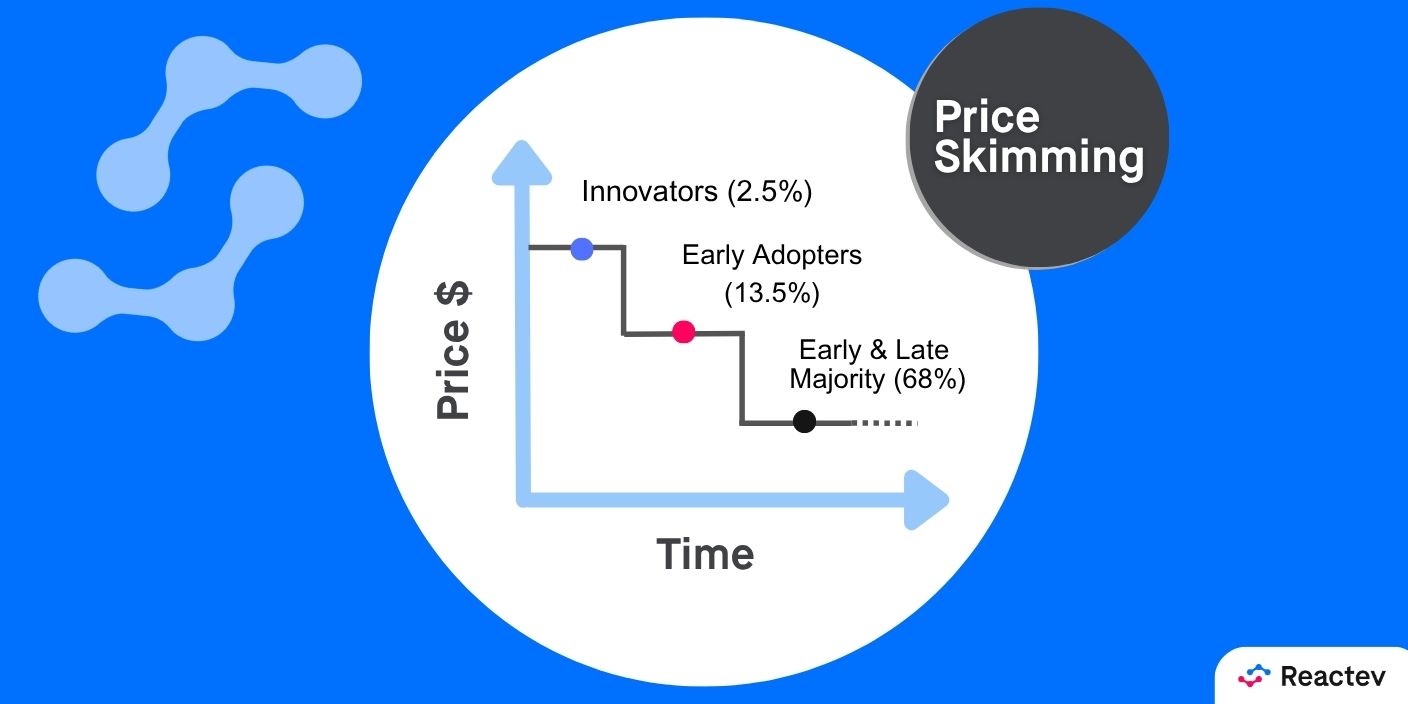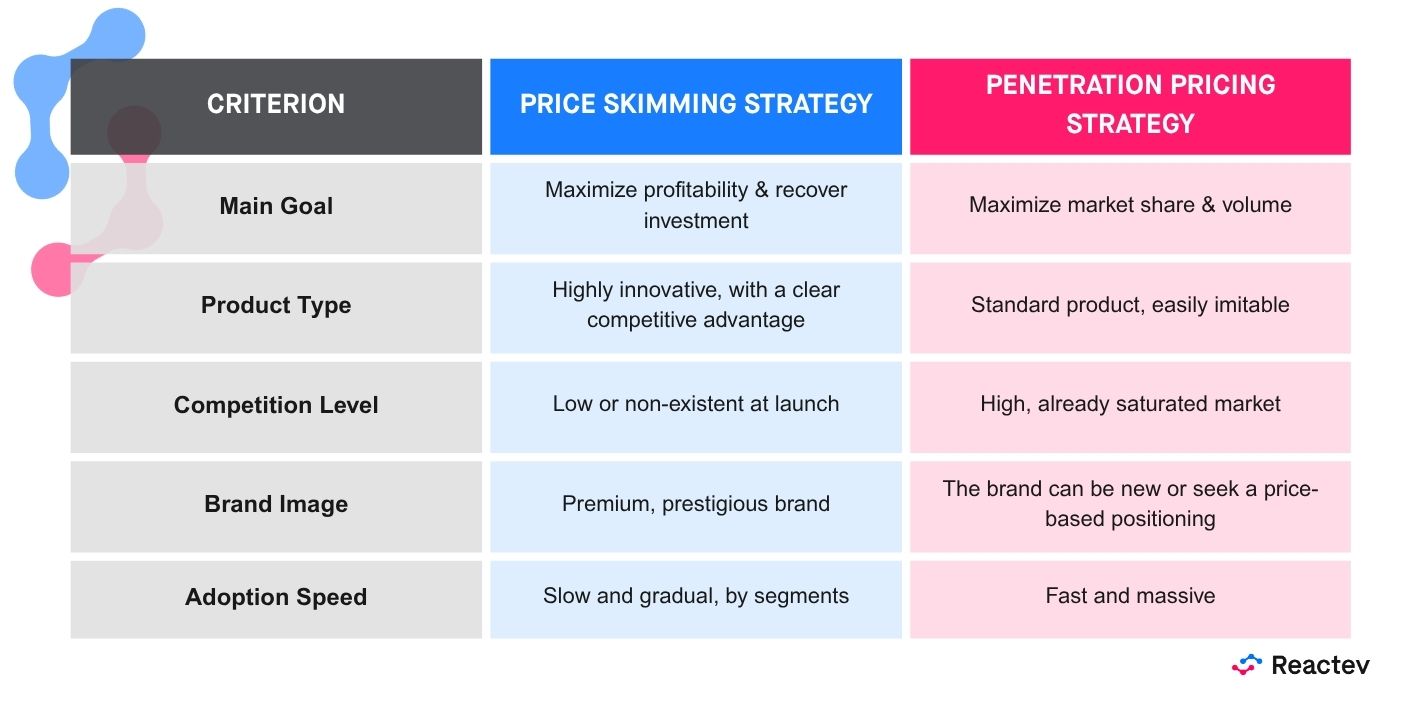
Price Skimming Strategy: What It Is, When to Use It & Examples
08/20/2025 - Pricing strategy
For major retail companies, every innovative product launch presents a critical challenge: how do you maximize profitability and prestige from day one? The answer often lies in a bold, calculated pricing approach. The price skimming strategy, also known as market skimming, is one of the most powerful solutions to this challenge. Among the wide range of pricing strategies, price skimming is a particularly effective model for very specific launch scenarios. In this complete guide, we'll break down what it is, when it's the right choice, and how industry giants have used it to dominate their sectors.
What Is Price Skimming?
The price skimming strategy involves launching a new product at a deliberately high initial price, targeting a segment of consumers willing to pay a premium for novelty and exclusivity. As the initial demand from this group is met and competition begins to emerge, the price is gradually lowered to attract other, more price-sensitive market segments.
The theory behind this strategy aligns with Everett Rogers' "Diffusion of Innovations" curve, which states that only a small percentage of the market (the Innovators and Early Adopters, roughly 16%) will adopt a product in its initial phase. These consumers are not only less price-sensitive, but their early adoption also builds a perception of prestige and validates the product for the subsequent majorities.
Far from being an "unfair" tactic, price skimming is a strategic tool that allows brands to quickly recover the high Research and Development (R&D) costs associated with innovation. It funds progress and lays the groundwork for the product to become accessible to a wider audience over time.
When Is Price Skimming a Good Idea?
The success of a skimming price policy is not universal; it depends on a very specific set of market and product conditions. Its application is ideal when the following requirements are met:
Highly Innovative Product
The product must offer a unique, tangible advantage that clearly sets it apart from any existing alternatives. Whether due to its technology, design, or functionality, it must be perceived as a significant breakthrough that justifies its premium price.
Little to No Competition
Price skimming is most effective in a "blue ocean" environment, where the product is the first or best in its category at launch. The absence of direct competitors gives the company a temporary monopoly to set prices.
Strong Brand Image
Companies with a solid reputation and a high degree of credibility can implement this strategy more successfully. Consumers trust that the high price corresponds to superior quality and value, thanks to the brand's prestige.
Initial Inelastic Demand
It is crucial that the early adopter segment has relatively inelastic demand, meaning their desire for the product is not significantly affected by the high initial price. They value novelty and status more than cost.
Famous Price Skimming Examples We All Know
Some of the world's most successful brands have mastered the art of price skimming to solidify their leadership and profitability.
Tesla and the Automotive Industry
Tesla is a textbook case study. It first launched its high-end, high-priced models, like the Model S and Model X, aimed at tech enthusiasts with high purchasing power. Once it recovered its investment and cemented its innovative brand image, it introduced more affordable models like the Model 3 and Model Y to capture the mass market.
Nike and Fashion Retail
In the apparel and footwear sector, Nike masterfully uses price skimming with its limited-edition sneaker launches, such as the Air Jordan lines or special collaborations. These products are released at high prices, generating enormous hype and a perception of exclusivity. Later, more accessible general-release models are launched for the rest of the market.
Sony and the Console Market
The lifecycle of video game consoles like the PlayStation perfectly illustrates this strategy. They are launched at a high initial price for the most dedicated gamers and early adopters. Over time, as production costs decrease, Sony lowers the price and introduces more affordable versions (like the "Slim" models) to attract a broader, more family-oriented audience.
Price Skimming: Advantages and Disadvantages
Like any strategic decision, opting for price skimming involves a balance of benefits and risks that must be carefully evaluated.
Advantages of Price Skimming
- Maximizes Revenue by Segment: It allows you to "skim" the maximum consumer surplus from each segment, extracting the most possible revenue at each stage of the product lifecycle.
- Rapid Return on Investment: The high initial margins help to quickly amortize the substantial R&D and marketing costs associated with the launch.
- Creates a Premium Brand Image: A high price can create a perception of quality, luxury, and exclusivity, strengthening the brand's positioning.
- Natural Market Segmentation: The strategy effectively segments customers based on their willingness to pay, allowing marketing messages and offers to be tailored over time.
Disadvantages and Risks to Consider
- Attracts Competition: High profit margins are a clear signal for other competitors to enter the market, accelerating the end of the temporary monopoly.
- Image Risk: A price reduction that is too fast or drastic can alienate early adopters who paid the full price, potentially damaging loyalty.
- Limits Initial Sales Volume: By definition, the strategy sacrifices initial sales volume in favor of a higher margin per unit.
- Requires Powerful Value Communication: The high price must be justified by a superior perceived value, which demands a highly effective marketing and communication effort.
Price Skimming vs. Penetration Pricing: Which Strategy Should You Choose?
The direct alternative to price skimming is penetration pricing, which involves launching a product at a low initial price to quickly gain market share. The choice between them is a decision that depends entirely on business objectives and is key to defining the optimal launch price.
The following table summarizes the key differences to help you make the right choice:

Do you launch products frequently? Discover how to simulate your launch pricing strategy to ensure maximum profitability with Price Strategy Simulation.
Frequently Asked Questions about price skimming strategy
What is the main goal of the price skimming strategy?
The main goal is not to achieve high initial sales volume but to maximize profitability from each customer segment. It seeks to capture the maximum value from early adopters willing to pay more, allowing for a rapid recovery of R&D investment.
Does price skimming work for any type of product?
No. It's a niche strategy that works best for highly innovative products with a strong competitive advantage and little to no competition at launch. Furthermore, it requires the brand to have a prestigious image to justify the premium price.
What is the biggest risk of using price skimming?
The main risk is twofold: first, a poorly communicated price drop can create resentment among early buyers who paid the full price. Second, the high profit margins act as a magnet, attracting competition much more quickly.
From Tactic to Data: Price Skimming as a Strategic Decision
The price skimming strategy is much more than a simple tactic for setting high prices. It is a powerful, strategic tool that, when applied under the right conditions, can define the success of an innovative product, fund future growth, and build an aspirational brand image.
However, its success depends not on instinct, but on flawless, data-driven execution. Understanding the demand elasticity of each segment, monitoring the entry of competitors, and knowing exactly when and how much to lower the price are critical decisions that cannot be left to chance.
Whether you choose Price Skimming or Penetration, the key is to make data-driven decisions. Request a demo and discover how Reactev can help you implement the perfect pricing strategy for every product.
Category: Pricing strategy
